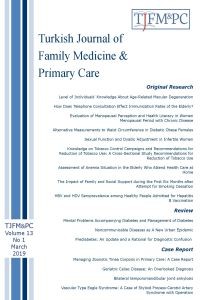Abstract
References
- 1. Gawkrodger D, Ardern-Jones MR. Dermatology: an illustrated colour text. Elsevier Health Sciences; 2016. p.30-31.
- 2. Gupta AK, Tu LQ. Dermatophytes: Diagnosis and treatment. J Am Acad Dermatol. 2006 Jun;54(6):1050–5.
- 3. Crawford F, Hollis S. Topical treatments for fungal infections of the skin and nails of the foot. Cochrane Database Syst Rev. 2007;3.
- 4. Europe W. The European definition of general practice/family medicine. Barc WONCA Eur. 2002.
- 5. Aytimur, Derya, S. E. Yuksel, and I. Ertam. "A case with tinea corporis et faciei due to Microsporum canis from a symptomatic cat." Ege Medicine J 44 (2005): 67-9.
- 6. Gerçeker B, Ertam İ, Aytimur D. Olgu Sunumu: Kediden Bulaşan Bir Tinea Korporis Olgusu. Sürekli Tıp Eğitimi Dergisi (STED) 13.10 (2004): 392-3.
- 7. Kokollari F, Daka A, Blyta Y, Ismajli F, Haxhijaha-Lulaj K. Tinea Corporis, Caused by Microsporum Canis - a Case Report From Kosovo. Med Arch. 2015 Oct;69(5):345–6. 8. Mancianti F, Nardoni S, Corazza M, D’achille P, Ponticelli C. Environmental detection of Microsporum canis arthrospores in the households of infected cats and dogs. J Feline Med Surg. 2003;5(6):323–8.
- 9. Nardoni, Simona, et al. "Open-field study comparing an essential oil-based shampoo with miconazole/chlorhexidine for haircoat disinfection in cats with spontaneous microsporiasis." J Feline Med Surg. 19.6 (2017): 697-701.
Abstract
Tinea corporis is a fungal infection caused by
various dermatophytes. It is mostly seen on trunk and mostly represented with
an annular plaque with erythematous border. Although it is presented with a
typical lesion, even if the patient applies to primary care, it is mostly
diagnosed and treated in secondary and tertiary care in Turkey. We present a
27-year-old woman that applied to primary care with an itchy, circular lesion.
The woman was diagnosed with zoonotic tinea corporis due to Microsporum canis
infection and treated in our Family Medicine Training Primary Healthcare Center
successfully. This case is one of the few cases in the literature about the
diagnosis and management of zoonotic tinea corporis in primary care. In order
to decrease the workload and healthcare costs in secondary and tertiary care,
management of these kinds of diseases in primary care should be encouraged.
Tinea korporis, çeşitli dermatofitlerin neden
olduğu bir mantar enfeksiyonudur. Sıklıkla gövdede, eritemli sınırları olan
dairesel bir plak olarak kendini gösterir. Tipik bir lezyon ile kendini
göstermesine rağmen, hasta birinci basamak sağlık kuruluşuna başvursa dahi,
Türkiye'de sıklıkla ikinci ve üçüncü basamak sağlık kuruluşlarında tanı almakta
ve tedavi edilmektedir. Burada birinci basamak sağlık kuruluşuna kaşıntılı ve
yuvarlak bir lezyonla başvuran 27 yaşında bir kadın hastayı sunmaktayız. Hasta,
Eğitim Aile Sağlığı Merkezi'mizde Microsporum canis enfeksiyonuna bağlı tinea
korporis tanısı almış ve başarılı bir şekilde tedavi edilmiştir. Bu olgu,
literatürde birinci basamakta zoonoz enfeksiyona bağlı tinea korporis'in tanısı
ve tedavisi ile ilgili olarak yer alan sayılı olgu sunumlarından biridir.
İkinci ve üçüncü basamak sağlık kuruluşlarının iş yükünü ve sağlık
harcamalarını azaltabilmek için, aile hekimleri bu gibi hastalıkların birinci
basamak sağlık kuruluşlarında yönetilmesi konusunda cesaretlendirilmelidir.
References
- 1. Gawkrodger D, Ardern-Jones MR. Dermatology: an illustrated colour text. Elsevier Health Sciences; 2016. p.30-31.
- 2. Gupta AK, Tu LQ. Dermatophytes: Diagnosis and treatment. J Am Acad Dermatol. 2006 Jun;54(6):1050–5.
- 3. Crawford F, Hollis S. Topical treatments for fungal infections of the skin and nails of the foot. Cochrane Database Syst Rev. 2007;3.
- 4. Europe W. The European definition of general practice/family medicine. Barc WONCA Eur. 2002.
- 5. Aytimur, Derya, S. E. Yuksel, and I. Ertam. "A case with tinea corporis et faciei due to Microsporum canis from a symptomatic cat." Ege Medicine J 44 (2005): 67-9.
- 6. Gerçeker B, Ertam İ, Aytimur D. Olgu Sunumu: Kediden Bulaşan Bir Tinea Korporis Olgusu. Sürekli Tıp Eğitimi Dergisi (STED) 13.10 (2004): 392-3.
- 7. Kokollari F, Daka A, Blyta Y, Ismajli F, Haxhijaha-Lulaj K. Tinea Corporis, Caused by Microsporum Canis - a Case Report From Kosovo. Med Arch. 2015 Oct;69(5):345–6. 8. Mancianti F, Nardoni S, Corazza M, D’achille P, Ponticelli C. Environmental detection of Microsporum canis arthrospores in the households of infected cats and dogs. J Feline Med Surg. 2003;5(6):323–8.
- 9. Nardoni, Simona, et al. "Open-field study comparing an essential oil-based shampoo with miconazole/chlorhexidine for haircoat disinfection in cats with spontaneous microsporiasis." J Feline Med Surg. 19.6 (2017): 697-701.
Details
| Primary Language | English |
|---|---|
| Subjects | Internal Diseases |
| Journal Section | Case Report |
| Authors | |
| Publication Date | March 11, 2019 |
| Submission Date | April 16, 2018 |
| Published in Issue | Year 2019 Volume: 13 Issue: 1 |
English or Turkish manuscripts from authors with new knowledge to contribute to understanding and improving health and primary care are welcome.


